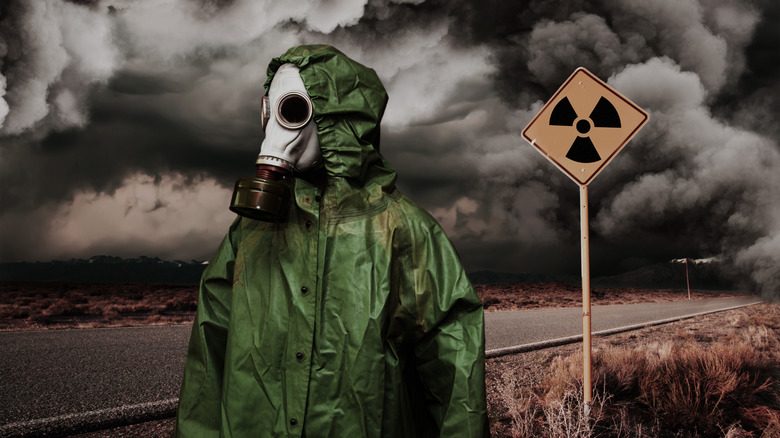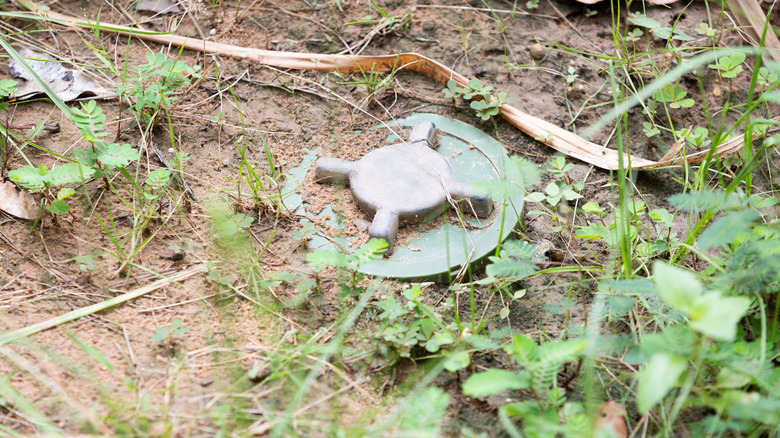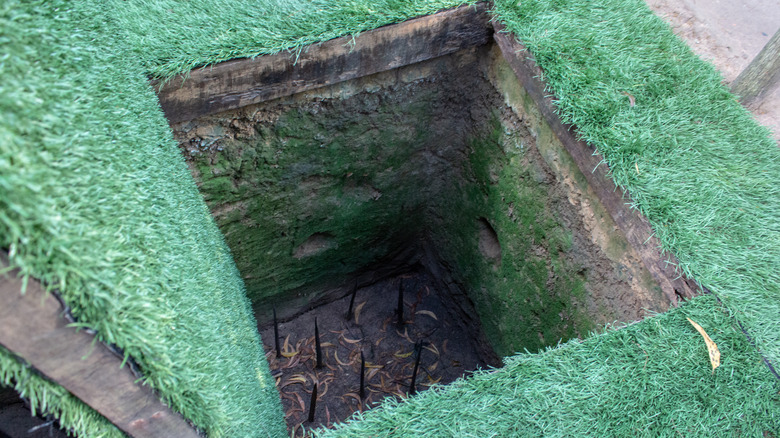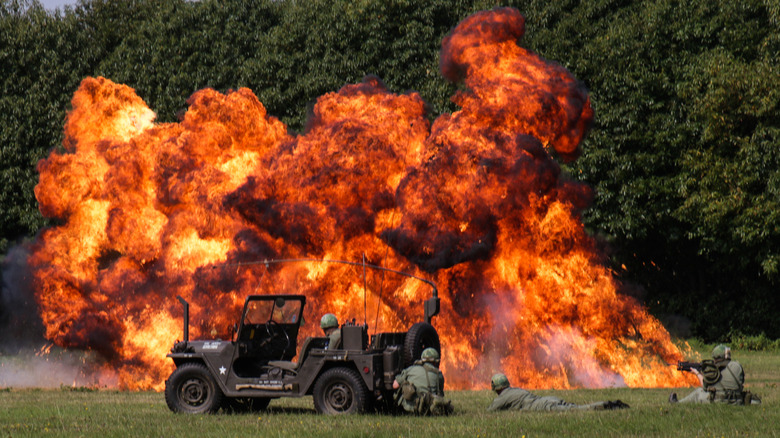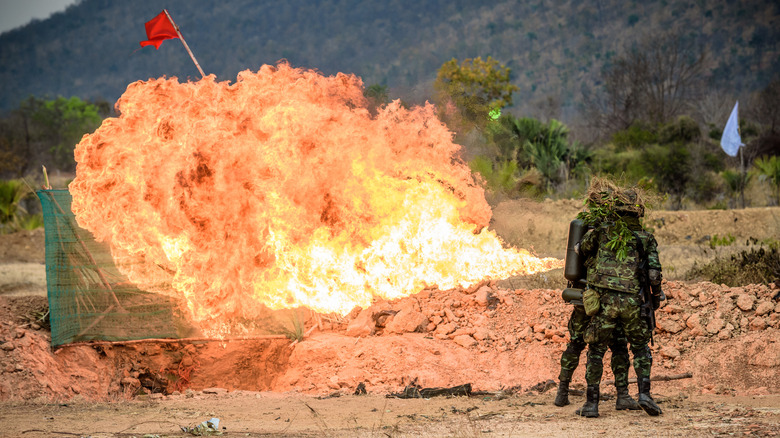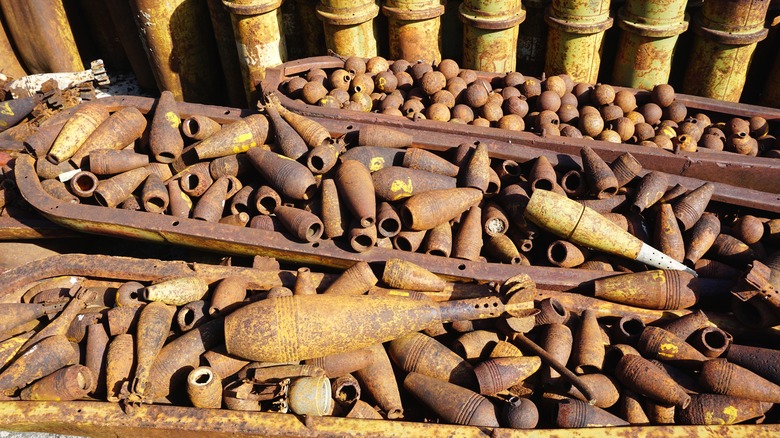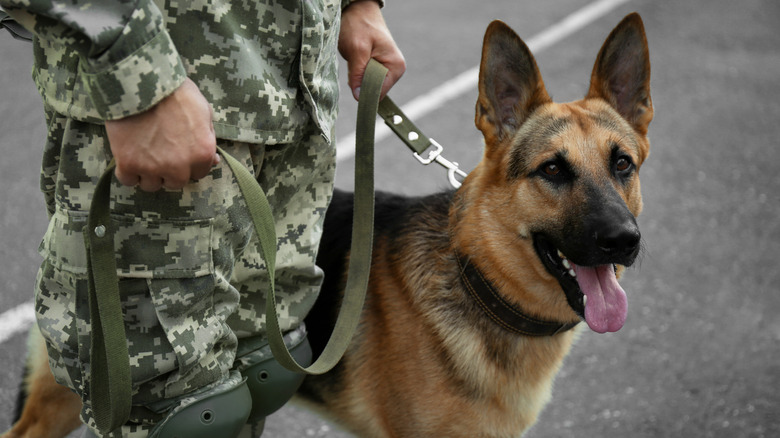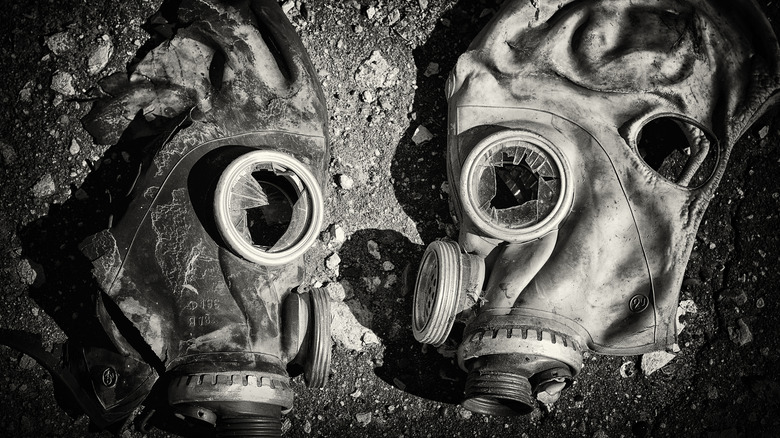Weapons That Are Too Dangerous For War
For hundreds of years, soldiers have conformed to customs that maintain some form of humanity in armed conflicts. For example, during the American Revolutionary War, British soldiers did not go out of their way to butcher American prisoners of war. When the British were eventually surrounded at Yorktown, they surrendered and expected the same treatment. Following suit, the American and French troops allowed officers to return to England and released British soldiers when the war was officially over. The main reason to follow such rules in the past would therefore be in the hopes that whatever respect you afford the enemy, the same would be reciprocated back to you.
As technology and weaponry progressed, so did the development of human rights and laws. Countries had learned from their mistakes and saw the true horrors their weapons could unleash. Perhaps fearful of repeating the past, or escalating suffering to new heights, international laws and treaties were codified to ban certain weapons. The Geneva Convention has since been ratified by all 196 states, forming the core element of international humanitarian law. A breach of the laws would therefore constitute war crimes and a potential trial in an International Criminal Court.
We have therefore compiled a list of weapons that are too dangerous for war and the extent to which they are regulated. While some have been used in the past, or are still in early development, others are easily available to the public outside warfare.
Landmines
Landmines come in two variants, anti-personnel and anti-vehicle. Anti-personnel mines are small explosives placed under, on, or near the ground. These weapons are victim-activated, and, detonate when someone steps on them or comes near them. Originally used in World War II, they have since been utilized in many other conflicts including the Vietnam War, the Korean War, and the first Gulf War.
Unfortunately, anti-personnel landmines do not discriminate against their chosen targets, as anyone can fall prey to their discreet nature. The suffering occurred by victims is horrific, with almost all survivors requiring multiple operations, and physical rehabilitation. Victims are also faced with psychological trauma due to the loss of a limb, and financial difficulties that follow with a permanent disability. With so many accidental casualties over the past decade, measures have been put in place to actively reduce the number of mine-free States.
In March 1999, the Anti-Personnel Mine Ban Treaty was implemented. The ban prohibited the use, stockpiling, production, and transfer of anti-personnel mines. Success-wise, there have been 133 signatures and a global halt on anti-personnel mine production, with a vast reduction in deployment. Furthermore, more than 40 million stockpiled mines have now been destroyed, with assistance being given to survivors and potentially affected areas. With that said, the fight isn't over, large areas of land are still infested with old war mines, and are yet to be made safe for productive use.
Punji sticks
The punji stick also known as spike pit, was a type of booby trap commonly used in the Vietnam War. The spikes were made from nearby wood or bamboo sources, and were eventually placed in a designated hole. The spikes were then camouflaged by natural undergrowth, grass, and leaves in the hope that a soldier might fall into the trap. Once the soldier fell inside, their foot or lower leg area would then be impaled and severely wounded.
While Hollywood films have greatly exaggerated the effects of spike pits, the original concept wasn't intended to kill the victim. They were designed to injure, slow down, and halt troops until additional medical support arrived. As the Viet Cong were heavily outnumbered by the United States forces, this technique was an excellent opportunity to ambush an unsuspecting unit or cover a retreat.
Although rarely fatal, punji sticks were still an incredibly cruel and painful weapon used against its victims. They were sometimes coated in poison, animal venom, or feces to cause infection later on. Similar to anti-personnel landmines, punji sticks did not discriminate or distinguish between their victims. As a result, accidental civilian casualties would follow.
The issue with most booby traps is not the weapon itself, but rather that they are installed and not dismantled after a war. Punji sticks were therefore banned under Protocol II of the 1980 Geneva Convention encompassing a list of dangerous and poisonous substances.
Napalm
Napalm is an incendiary explosive compound made from a mixture of a gelling agent and a volatile petrochemical. The gelling agent forms a crucial part of napalm's effectiveness, as it sticks to the target and burns for longer. When used as an incendiary weapon, napalm can reach temperatures of 1,200 °C (2,190 °F), causing severe burns, asphyxia, unconsciousness, or death. It's no surprise that it's therefore considered one of the most dangerous weapons on the planet.
The earliest use of napalm occurred in Berlin on the 16th of March 1944 by the United States. One napalm bomb alone could damage an area of 2,100 square meters (2,500 sq yd). Napalm was also incredibly effective for dug-in enemy personnel, as the incendiary composition could easily flow inside bunkers and tunnels. It was later used in the Korean War, and finally the Vietnam War.
Vietnam was a turning point, as unlike before, the effects of napalm were broadcasted to the public. People didn't like what they saw, from burning forests to destroyed villages. Even more so, the infamous photograph of 9-year-old Phan Thi Kim Phùc fleeing a napalm attack with burns all over her body.
With public protests such as rallies led by Rev. Dr. Martin Luther King and other civil rights movement leaders, the use of napalm against civilian populations was outlawed in 1980. As for military targets, well, Protocol III of the UN Convention on Conventional Weapons leaves this area somewhat vague.
Balloon bombs
In the past, European powers had previously agreed to prohibit the use of Balloon bombs at the Hague Convention of 1907. However, this did not stop countries such as Japan from using them during World War II. Japan launched more than nine thousand balloon bombs against the United States during the period between November 1944 and April 1945. Considered a low-tech weapon, these balloons were filled with hydrogen or helium, and were attached to a bomb, incendiary device, or molotov cocktail.
The balloon would then be carried by wind where it would fall and release its payload. Due to their random nature, balloon bombs were quite ineffective, with only three hundred bombs ever making it over the Pacific Ocean. Japan hoped that the bombs would cause general mayhem in the United States, and unfortunately, towards the end of the war, the world saw the misery these weapons could inflict.
On the 5th of May 1945, a family in Oregon discovered a balloon that had landed. Curious and unknowing of its intent they approach the device. The bomb exploded, killing a woman and her five children, making them the only fatalities caused by the enemy on American soil. To prevent the public from panicking, the United States military censored reports. The military later issued a warning to the public to be aware of any strange white balloons they may encounter. The incident served as a reminder as to why these weapons should be banned.
Flamethrowers
Flamethrowers were used during World War I and II. They were extremely effective against battlefield fortifications, bunkers, trenches, and other protected emplacements. Once activated, a stream of flammable liquid would erupt into a flame that could then engulf nearby enemies.
However, flamethrowers were not exactly the perfect weapon. They posed a risk to the operator because of the weapon's weight and range making the user an easy target. With a limited fuel supply, it was only a matter of time before soldiers had to run for cover.
Flamethrowers also followed the same consequences and risks of napalm, as they had the potential to cause severe burns, asphyxia, or death. Consequently, they were moderated by the same conditions set under Protocol III of the Convention on Certain Conventional Weapons. While not banned in its entirety, they were severely limited in the operations they could perform in the future.
Under Protocol III, flamethrowers could not be used against military targets if they were within a civilian concentrated area. Fire spreads quite easily, so it rendered the weapon pretty much useless for combat. Furthermore, plants and forests were not allowed to be torched unless military objects were confirmed to be hidden.
With the risk of possible war crimes and their ineffective nature in present-day warfare, flamethrowers were set aside as a weapon of the past. Funny enough, they're still perfectly legal in the United States — Elon Musk's Boring Company flamethrowers were a popular buy in their time. They're now considered tools.
Non-detectable fragments
Protocol I of the Convention on Certain Conventional Weapons restricts weapons with non-detectable fragments. In other words, countries cannot employ weapons that leave behind bits that are then concealed from medical equipment. An example would be plastic shards from an explosive. These kinds of materials are known to avoid detection on medical equipment such as x-rays.
This rule was also supported well before Protocol I as set out in the UK Military Manual. Although no mention of plastics is made, the manual does specify the effects of glass as a non-detectable fragment. As a projectile, the glass would cause pain and suffering that is beyond what is necessary during warfare, and should therefore be prohibited and limited in use.
The same concept was reaffirmed within international humanitarian law which limits superfluous injury. Surgeons would potentially have to go through the entire body by hand to locate the non-detectable fragment. Combat medics in particular, with limited healthcare resources, would indirectly add additional pain and anguish to non-sedated victims.
With that said, the most important factor when accounting for non-detectable fragments is the prohibition against the primary effect only. Materials such as plastic or glass can be used in the production process, but cannot be part of the design that is used to injure the person. Plastic framed guns or glass scopes are therefore perfectly fine, but, plastic or glass explosives? Not so much.
Cluster bombs
A cluster munition, also known as a cluster bomb, is a container filled with hundreds of smaller bomblets. The container can take the form of a shell, rocket, or missile, and can be fired from howitzers, artillery guns, or rocket launchers. Cluster bombs can scatter across several acres of land without any degree of accuracy. While incredibly dangerous and effective as a weapon that can maim and kill, the victims are hardly ever military personnel.
The reasoning behind this is that up to 40% of sub-munitions do not explode on impact. This may be due to a technical fault that prevents the bombs from exploding, or that the ground is too soft. Whatever the case, the bombs present the same threat as an anti-personnel landmine would, detonation and destruction years after a conflict has ended.
A sad example of this type of warfare can be seen in Laos. Although conflicts occurred between 1964 and 1973, the sub-munitions that did not explode are still claiming lives today. Statistics show that up to 97% of recorded victims tend to be civilians, and more often children.
With a trail of civilian death and psychological trauma left behind, a treaty was developed to outlaw the future of cluster bombs. In August 2010, the Convention on Cluster Munitions banned the use, production, trade, and stockpiling of cluster bombs. A framework was also established to assist victims, and clear contaminated sites, with 123 states committing to the goal as of February 2022.
Expanding bullets
Expanding bullets were designed to flatten inside the body. These bullets widen on impact and create a much larger wound when compared to generic ammunition. A modern example is the ever-popular hollow point. What makes them truly unique, however, is that they are used by both hunters and policemen, but are prohibited by militaries around the world.
Why are police departments and hunters using them? Well, expanding bullets are less likely to pass through their targets, and reduce the accidental risk of injury to innocent bystanders. Hunters also favor these types of rounds because of their stopping power and the increased chance of a quick kill.
Expanding bullets is therefore a controversial topic and a balancing of the greater good. Hunters can effectively use them to prevent the loss of game, while policemen can neutralize an aggressor, and at the same time prevent collateral damage. So, why does the legality shift during a war?
In 1897 the German government lodged a complaint against the Mark IV bullet, which was an earlier iteration of an expanding bullet. They claimed that it was excessive, inhumane, and violated the rules of war. Wounds to soldiers caused great damage to internal organs and tissue, and could potentially diminish one's standard of life after the war. Their protests were successful, and during the Hague Convention, Declaration III prohibited the use of expanding bullets in international warfare.
Biological weapons
Biological weapons are infectious germs or toxins that have been created with the sole purpose of either killing, harming, or incapacitating targets. They can come in the form of viruses, bacteria, fungi, or insects, and can result in a large number of civilian casualties.
Biological weapons may take a few days to become effective, but once active, the results can be catastrophic. Biological agents such as Ebola and smallpox are highly contagious and have the capability of person-to-person transmission. For example, the latter was used during the French and Indian Wars. Soldiers distributed blankets that had been used by smallpox victims in the hopes of initiating outbreaks among American Indian tribes. Fortunately, nobody has gotten smallpox naturally since 1977, and there have been no reports of the Ebola virus being used in bio-terrorism as of now.
Since biological weapons are difficult to detect and can spread to unintended populations, (including neutral and friendly forces) the use of such weapons was effectively banned by the 1972 Biological Weapons Convention (BWC). Similar to the restrictions placed on landmines and cluster bombs, the BWC supplemented the Geneva Convention by prohibiting the development, production, acquisition, transfer, stockpiling, and use of biological weapons.
The preamble goes on to state that the use of biological weapons would be "repugnant to the conscience of mankind." As of May 2022, 184 states have ratified or acceded to the BWC. Despite biological weapons being considered a war crime, defensive biological research continues to this day.
Weaponized animals
Animals have been used for a variety of functions during the history of warfare. Horses were the most notable for carrying supplies and providing speedy transportation. Homing pigeons could relay messages, while cats could control vermin aboard ships. Although trained animals are perfectly legal when assisting the war effort, issues arise when they are directly weaponized.
During World War II dogs were strapped with explosives and used as anti-tank weapons. Although this is up for debate, using these types of strategies today would surely violate Protocol III of the 1980 Convention on Certain Conventional Weapons, and the prohibitions against incendiary weapons. Dogs can fail to tell the difference between civilians and military targets, and then there's of course the cruelty aspect of kamikaze canines.
As a potential courier for bio-terrorism, rats can also be used to deliberately spread germs and toxins. Since rodents are common in both urban and rural settlements, infection would spread rapidly. Once again, this would fall under the biological weapon ban of the 1972 Biological Weapons Convention. The possibilities are therefore endless in terms of animal weaponization, with little to no clarity on present treaties and conventions.
While organizations such as PETA might advocate for the complete removal of animals from warfare, we have yet to see a direct international law that provides protection or limitations for their uses. We can only hope that their protection and preservation (such as special hats for combat dogs) continue to become a greater concern in the future.
Chemical weapons
Chemical weapons are classified as weapons of mass destruction. They can harm a great many individuals at once and have the ability to damage buildings, natural structures, and the biosphere. Using the toxic properties of a chemical substance, a lethal agent can kill an opposing force, destroy vegetation to deny concealment, or remove livestock to promote hunger among a population.
Similar to biological weapons, chemical weapons are hard to contain once released. They can be dispersed in a solid, gas, or liquid form, and affect anyone within their proximity. These attacks can be launched via aircraft, rocket, or remote-controlled container release.
Modern examples include mustard gas, which can form large blisters on exposed skin, and, nerve gas which breaks down the neurotransmitters that allow organs to function. Most chemical weapon attacks result in death, or at the very least, lifelong health issues.
Under the Chemical Weapons Convention of 1993, there is a worldwide ban on the production, stockpiling, and use of chemical weapons and their precursors. Unfortunately, this has not stopped terrorist attacks, as a Tokyo subway fell victim to the deadly nerve gas sarin in 1995. Large stockpiles also continue to exist worldwide, justified as a precaution against possible use by an aggressor.
While storage over long periods of time remains dangerous, countries such as the United States are currently undergoing measures to dispose of their chemical weapons safely.
Blinding laser weapons
If you're a fan of the Terminator franchise, perhaps you'll remember the opening scene of Terminator 2: Judgement Day, which showed the malevolent artificial intelligence Skynet attacking the last human resistance. While the CGI and practical effects were ahead of their time, most viewers didn't realize that the fictional laser weapons used by the machines were actually in development.
According to CNN, in 2020, the US successfully tested a laser weapon that could destroy an aircraft mid-flight. Other uses include using a laser to identify your signature heartbeat from over 600 feet away. This has opened our eyes to the possibility of laser warfare in the future, and what, if any, limitations are placed on their capabilities. The good news is, there is a restriction, but it's not quite what you'd expect.
Protocol IV of the 1980 Convention on Certain Conventional Weapons, states that laser weapons that are designed solely to cause permanent blindness to unenhanced vision are strictly prohibited. Unenhanced vision entails any soldier not using binoculars, telescopes, or other optical equipment on the battlefield. Therefore, laser weapons that cause blindness due to an accident or a collateral effect will not be considered war crimes.
As a somewhat flexible protocol, we have seen certain countries push the boundaries for research purposes. A 1990 report in the Defense News stated that the US military had already conducted tests on two-handed laser weapons that could blind targets during combat. Being a new method of warfare, we can only hope it remains in its experimental stages. Skynet won't conform to any laws or treaties.
